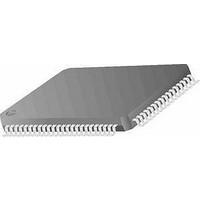MC9S12E64CFU Freescale Semiconductor, MC9S12E64CFU Datasheet - Page 198

MC9S12E64CFU
Manufacturer Part Number
MC9S12E64CFU
Description
IC MCU 64K FLASH 25MHZ 80-QFP
Manufacturer
Freescale Semiconductor
Series
HCS12r
Specifications of MC9S12E64CFU
Core Processor
HCS12
Core Size
16-Bit
Speed
25MHz
Connectivity
EBI/EMI, I²C, SCI, SPI
Peripherals
POR, PWM, WDT
Number Of I /o
60
Program Memory Size
64KB (64K x 8)
Program Memory Type
FLASH
Ram Size
4K x 8
Voltage - Supply (vcc/vdd)
2.35 V ~ 2.75 V
Data Converters
A/D 16x10b; D/A 2x8b
Oscillator Type
Internal
Operating Temperature
-40°C ~ 85°C
Package / Case
80-QFP
Data Bus Width
16 bit
Data Ram Size
4 KB
Interface Type
SCI, SPI
Maximum Clock Frequency
25 MHz
Number Of Programmable I/os
60
Number Of Timers
16 bit
Maximum Operating Temperature
+ 85 C
Mounting Style
SMD/SMT
Minimum Operating Temperature
- 40 C
On-chip Adc
10 bit
On-chip Dac
8 bit, 2 Channel
For Use With
M68EVB912E128 - BOARD EVAL FOR MC9S12E128/64
Lead Free Status / RoHS Status
Contains lead / RoHS non-compliant
Eeprom Size
-
Lead Free Status / Rohs Status
No RoHS Version Available
Available stocks
Company
Part Number
Manufacturer
Quantity
Price
Company:
Part Number:
MC9S12E64CFU
Manufacturer:
Freescale Semiconductor
Quantity:
10 000
Company:
Part Number:
MC9S12E64CFUE
Manufacturer:
Freescale Semiconductor
Quantity:
10 000
Part Number:
MC9S12E64CFUE
Manufacturer:
FREESCALE
Quantity:
20 000
Company:
Part Number:
MC9S12E64CFUER
Manufacturer:
Freescale Semiconductor
Quantity:
10 000
- Current page: 198 of 606
- Download datasheet (4Mb)
Chapter 4 Clocks and Reset Generator (CRGV4)
The internal reset of the MCU remains asserted while the reset generator completes the 192 SYSCLK long
reset sequence. The reset generator circuitry always makes sure the internal reset is deasserted
synchronously after completion of the 192 SYSCLK cycles. In case the RESET pin is externally driven
low for more than these 192 SYSCLK cycles (external reset), the internal reset remains asserted too.
4.5.1
The CRGV4 generates a clock monitor reset in case all of the following conditions are true:
The reset event asynchronously forces the configuration registers to their default settings (see
“Memory Map and Register
doesn’t change the state of the CME bit, because it has already been set). As a consequence, the CRG
immediately enters self-clock mode and starts its internal reset sequence. In parallel the clock quality
check starts. As soon as clock quality check indicates a valid oscillator clock the CRG switches to
OSCCLK and leaves self-clock mode. Because the clock quality checker is running in parallel to the reset
generator, the CRG may leave self-clock mode while completing the internal reset sequence. When the
reset sequence is finished the CRG checks the internally latched state of the clock monitor fail circuit. If a
clock monitor fail is indicated processing begins by fetching the clock monitor reset vector.
4.5.2
When COP is enabled, the CRG expects sequential write of 0x0055 and 0x00AA (in this order) to the
ARMCOP register during the selected time-out period. As soon as this is done, the COP time-out period
restarts. If the program fails to do this the CRG will generate a reset. Also, if any value other than 0x0055
or 0x00AA is written, the CRG immediately generates a reset. In case windowed COP operation is enabled
198
•
•
•
Clock monitor is enabled (CME=1)
Loss of clock is detected
Self-clock mode is disabled (SCME=0)
Clock Monitor Reset
Computer Operating Properly Watchdog (COP) Reset
SYSCLK
RESET
Definition”). In detail the CME and the SCME are reset to logical ‘1’ (which
possibly
SYSCLK
not
running
CRG drives RESET pin low
MC9S12E128 Data Sheet, Rev. 1.07
) (
Figure 4-25. RESET Timing
128+n cycles
with n being
min 3 / max 6
cycles depending
on internal
synchronization
delay
) (
)
(
RESET pin
released
64 cycles
)
(
possibly
RESET
driven low
externally
)
(
Freescale Semiconductor
Section 4.3,
Related parts for MC9S12E64CFU
Image
Part Number
Description
Manufacturer
Datasheet
Request
R
Part Number:
Description:
Manufacturer:
Freescale Semiconductor, Inc
Datasheet:
Part Number:
Description:
Manufacturer:
Freescale Semiconductor, Inc
Datasheet:
Part Number:
Description:
Manufacturer:
Freescale Semiconductor, Inc
Datasheet:
Part Number:
Description:
Manufacturer:
Freescale Semiconductor, Inc
Datasheet:
Part Number:
Description:
Manufacturer:
Freescale Semiconductor, Inc
Datasheet:
Part Number:
Description:
Manufacturer:
Freescale Semiconductor, Inc
Datasheet:
Part Number:
Description:
Manufacturer:
Freescale Semiconductor, Inc
Datasheet:
Part Number:
Description:
Manufacturer:
Freescale Semiconductor, Inc
Datasheet:
Part Number:
Description:
Manufacturer:
Freescale Semiconductor, Inc
Datasheet:
Part Number:
Description:
Manufacturer:
Freescale Semiconductor, Inc
Datasheet:
Part Number:
Description:
Manufacturer:
Freescale Semiconductor, Inc
Datasheet:
Part Number:
Description:
Manufacturer:
Freescale Semiconductor, Inc
Datasheet:
Part Number:
Description:
Manufacturer:
Freescale Semiconductor, Inc
Datasheet:
Part Number:
Description:
Manufacturer:
Freescale Semiconductor, Inc
Datasheet:
Part Number:
Description:
Manufacturer:
Freescale Semiconductor, Inc
Datasheet:











